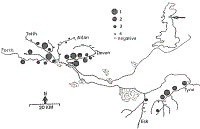 |
Last Update:
Friday November 23, 2018
|
| [Home] |
|
IUCN/SCC Otter Specialist Group Bulletin Volume 9 Pages 1 - 16 (March 1994) Citation: Macdonald, S.M. & Mason, C.F. (1994) PCBs And Organochlorine Pesticide Levels in Otter (Lutra lutra) Scats from Eastern Scotland IUCN Otter Spec. Group Bull. 9: 8 - 10 PCBs and Organochlorine Pesticide Levels in Otter (Lutra lutra) Scats from Eastern Scotland S.M. Macdonald and C.F. Mason Department of Biology, University of Essex, Wivenhoe Park, Colchester C04 3SQ, UK
INTRODUCTION During the 1977-79 survey of Scotland the otter (Lutra lutra) was shown to be
widespread over much of the country but poor results were obtained in the central and eastern
lowlands (Green & Green 1980). In Lothian region all 103 survey sites were negative but in early
1980 signs of otters were found at four sites on the Rivers Tyne and South Esk. When the
survey of Lothian was repeated in the mid-1980s, positive sites were again restricted to these
rivers (Green & Green 1987). By contrast, in Central region, of the 146 sites visited on both
surveys, 49 % were positive on the first occasion rising to 66 % on the second. Green & Green
(1987) point out that water quality had improved in the period between the two surveys and site
improvement in the Forth catchment as a factor influencing the increase in otter distribution in
Central region. However, water quality classification is based largely on BOD; the presence of
bioaccumulating contaminants such as organochlorine pesticides and PCBs, which most likely
caused the decline in otter populations (Mason 1989), is seldom investigated. It was of interest
therefore to examine levels of organochlorines in otters from these regions to ascertain whether
contamination might limit further expansion of the population. In the absence of otter tissues,
levels of OCs were determined in spraint (faeces) samples (see Mason et al. 1992, for rationale MATERIALS AND METHODS Sites were surveyed for otters in November 1992 following the method used in the national field surveys (e.g. Green & Green 1980). Spraint samples were collected, wrapped in aluminium foil, and deep-frozen (-20 °C) prior to analysis. Organochlorine concentrations were determined with a Varian 3300 gas chromatograph, with a tritium electron capture detector and using a 25 m capillary column. Details of sample preparation and analysis are given in Mason (1993). PCB concentrations were determined against an Arocolor 1260 standard. The detection level was 0.01 mg kg1. RESULTS AND DISCUSSION In Lothian region, signs of otter presence were found at 9 to 14 sites on the Rivers Tyne and South Esk, while on the Forth catchment 25 to 30 sites proved positive. Thirty-five spraint samples were collected. Results are shown in Fig. 1. It has been suggested that, in spraints, levels of PCBs and dieldrin, singly or combined, of less than 4 mg kg1 lipid weight are of little concern while levels over 9 mg kg1 could be damaging to otters (Mason & Macdonald 1993). As can be seen, a few samples from the Forth and Teith contained contaminant levels greater than 9 mg kg1 (levels 1 and 2 in Fig. 1), these all being owing to the PCB content.
Samples from the river Allan were low in contaminant levels. On the River Devon no otter signs were found on the upper reaches but levels of contaminants in spraints increased progressively at downstream sites. Elevated levels were due largely to the PCB content but dieldrin levels were also high in samples collected close to the Alva industrial estate with its woollen mills. On the Tyne all samples from the middle and lower reaches contained levels greater than 9 mg kg1 this being owing both to PCBs and dieldrin. Means and ranges of PCBs and dieldrin in samples are given in Table 1. High levels of p,p-DDE were recorded on the middle and lower Tyne (mean = 12,83; range 16,12 = 9,06) and at a few sites on the Teith, Forth and Devon. Of the rivers sampled on the Forth catchment, the Devon was the most contaminated. No signs of otters were found on the upper reaches although, by contrast, Green & Green (1987) found signs only at upstream sites. It may be that the otter population on the Devon is underperforming due to contamination. Ormerod & Tyler (1992) also recorded elevated levels of PCBs in dipper (Cinclus cinclus) eggs on the Devon. In Lothian region Green & Green (1987) recorded the lowest percentage of positive sites and the lowest mean number of signs found per positive site of all regions in Scotland. It may be significant that, on the middle and lower reaches of the Tyne, spraints contained elevated levels of PCBs, dieldrin and p.p-DDE and contaminants may be limiting the expansion of the otter population in this region. REFERENCES Green, J. & Green, R. (1980) Otter survey of Scotland 1977-79. Vincent Wildlife Trust,
London. |
| [Copyright © 2006 - 2050 IUCN/SSC OSG] | [Home] | [Contact Us] |
